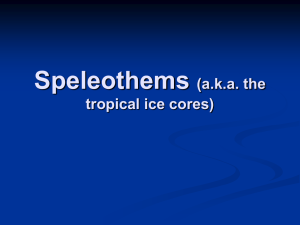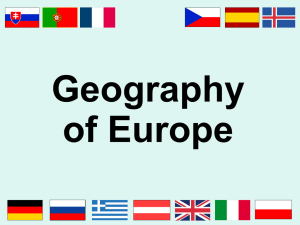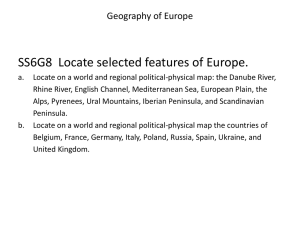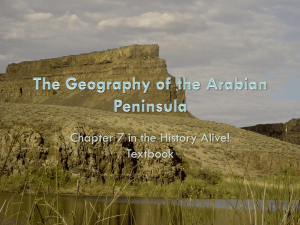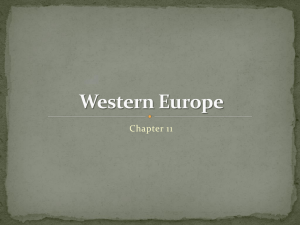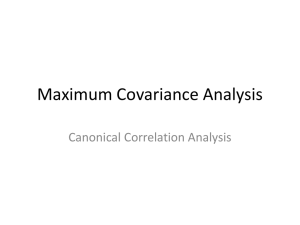Moreno
advertisement
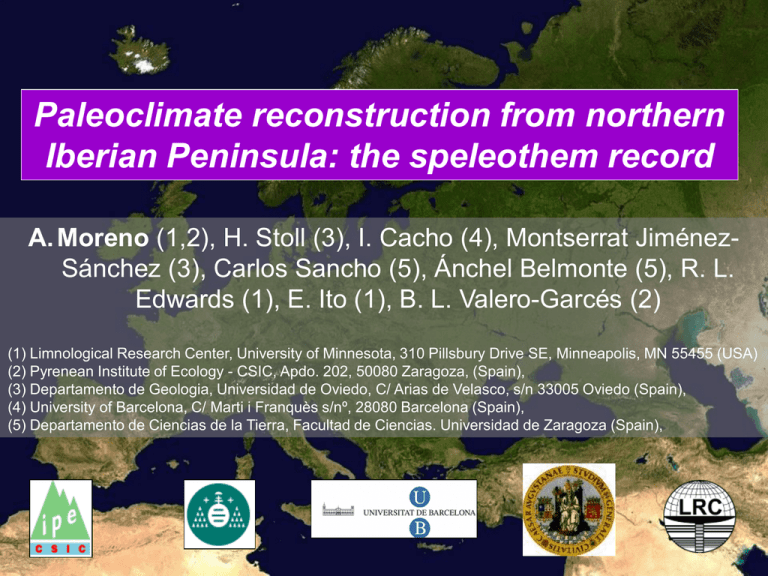
Paleoclimate reconstruction from northern Iberian Peninsula: the speleothem record A. Moreno (1,2), H. Stoll (3), I. Cacho (4), Montserrat JiménezSánchez (3), Carlos Sancho (5), Ánchel Belmonte (5), R. L. Edwards (1), E. Ito (1), B. L. Valero-Garcés (2) (1) Limnological Research Center, University of Minnesota, 310 Pillsbury Drive SE, Minneapolis, MN 55455 (USA) (2) Pyrenean Institute of Ecology - CSIC, Apdo. 202, 50080 Zaragoza, (Spain), (3) Departamento de Geologia, Universidad de Oviedo, C/ Arias de Velasco, s/n 33005 Oviedo (Spain), (4) University of Barcelona, C/ Marti i Franquès s/nº, 28080 Barcelona (Spain), (5) Departamento de Ciencias de la Tierra, Facultad de Ciencias. Universidad de Zaragoza (Spain), Outline Speleothems as exceptional paleoclimate archives Study sites in the north of the Iberian Peninsula Main questions Some preliminary results… Orbital scale Last deglaciation main trends Early Holocene abrupt changes Conclusions A. Moreno (IPE-CSIC) Speleothem records from the northern Iberian Peninsula Speleothems as exceptional paleoclimate archives Advantages - Absolute dating by using the U-Th desintegration series (0-500 kyrs) - High precipitation rate (banding) –abrupt/rapid climate changes - Good records of temperature and precipitation (stable isotopes, trace metals, growth rates…) Disadvantages - Only in karstic systems - System monitoring is required (lot of time and money….) - Presence of hiatus in dry or cold climates A. Moreno (IPE-CSIC) Speleothem records from the northern Iberian Peninsula Speleothems as exceptional paleoclimate archives Fairchild et al., 2006 A. Moreno (IPE-CSIC) Speleothem records from the northern Iberian Peninsula Speleothems as exceptional paleoclimate archives 2 initial assumptions: - Closed system to U and Th - Initial 230Th = 0 (“pure” Some sources of errors: samples, with low detrital) - Low U content (depends on the type of limestone) - High 232Th (high 230Th initial) - Post-precipitation effects A. Moreno (IPE-CSIC) Speleothem records from the northern Iberian Peninsula Speleothems as exceptional paleoclimate archives Diagenetic processes (evaluated by petrography to discard re-crystallization) Non-equilibrium fractionation (evaluated by d13C vs d18O correlation, replication or Hendy test) d18O Other fractionation (eg. evaporation of water in the soil or vadose zone) Cave Tª (seasonally stable, long-term variations can modulate the signal) d18O of rainfall Air temperature variations 0.34‰/ºC Variability in the precipitation sources NAO; glacial vs interglacial Amount of precipitation d13C values of the carbonate bedrock (fixed values) d13C d13C values of the soil CO2 Soil processes and residence time Type of vegetation overlying the cave (C3 vs C4) Vegetation cover overlying the cave Mg/Ca, Sr/Ca, Ba/Ca Marine aerosols – distance to the coast Prior calcite precipitation (link to dry/wet climates) A. Moreno (IPE-CSIC) Speleothem records from the northern Iberian Peninsula Study sites in the north of the Iberian Peninsula Cueva de las Güixas Cueva 5 de Agosto Sima de Estebán Felipe Cueva de Molinos Zonas calcáreas El Pindal and Calabrez caves A. Moreno (IPE-CSIC) CAVECAL-CICYT: Cambios climáticos rápidos en la Península Ibérica basados en calibración de indicadores, series instrumentales largas y análisis de alta resolución de registros en espeleotemas. DGA-LaCaixa: Formaciones de espeleotemas en Aragón: una innovadora aproximación a la reconstrucción del clima de los últimos milenios. Speleothem records from the northern Iberian Peninsula non-dolomitic limestones of the Carboniferous Barcaliente Formation EL PINDAL Old fluvial channel Pathway R2 = 0.85 Fluviokarstic and gravity features Speleothems Block accumulations Mud deposits Old alluvial deposits A. Moreno (IPE-CSIC) + Jiménez-Sánchez et al., 2002 Speleothem records from the northern Iberian Peninsula Dripstone Flowstone Complex Gours 5 de Agosto First stalagmites dated from the Spanish Pyrenees. High altitude cave (1664 m) Monitoring in progress (temperature, rainfall, dripwaters) A. Moreno (IPE-CSIC) Speleothem records from the northern Iberian Peninsula Main questions 1) Temporal and spatial reconstruction of main abrupt changes in the Northern Iberian Peninsula during the Pleistocene and Holocene 2) Interpretation of main mechanisms of abrupt climate change in the past, including phenomena affecting the most recent millennia (NAO, solar variability…) 3) Response of terrestrial ecosystems (hydrology, vegetation) to abrupt climate changes at different timescales (orbital, millennial, decadal) A. Moreno (IPE-CSIC) Speleothem records from the northern Iberian Peninsula At an orbital-scale Espeleothems from 5 de Agosto Cave (Central Pyrenees) only growth during short periods associated to interglacials: OIS 1, OIS 7, OIS 9, OIS 11. Surprisingly, there is no sample (after dating 16 stalagmites) growing during OIS 5 A. Moreno (IPE-CSIC) Speleothem records from the northern Iberian Peninsula At an orbital-scale Isotopes:d18O values very similar in the three interglacials; d13C has higher variability (particularly, OIS 7) d18O MAX MIN 5Agosto -1 Estadio 11 -5,62 -6,79 5 Agosto-10 Holoceno -5,74 -6,92 5 Agosto-14 Estadio 7 -5,9 -6,93 d13C MAX MIN 1,70 -1,3 -1,41 -4,5 4,13 1,55 Identify the growth periods as the warmer and wetter intervals Compare duration and characteristics of the last interglacials Look for an “analogous” for the Holocene (OIS 5??, OIS 11?) A. Moreno (IPE-CSIC) Speleothem records from the northern Iberian Peninsula During last deglaciation CAN sample covers from 25 to 8 kyrs ago with an interruption during the Mystery Interval (Denton, 2005), a particular time period characterized by an increase in sea CANDELA level but colder temperatures in Greenland and North Atlantic than during the LGM. We would expect a very cold, and probably dry, scenario for southern Europe. A. Moreno (IPE-CSIC) Speleothem records from the northern Iberian Peninsula GI-1 11000 HOLOCENE GS-1 PB Wetter NAO - 7.4 -1 2 13000 8.2 9.2 YD 15000 Gi-2 17000 GS-2a H1 OD 19000 21000 GS-2b LGM 23000 25000 GS-2C HE2 -3 6 10.3 -4 0 d13C (‰) -1 0 -4 4 -8 -4 8 -6 -6 -4 HIATUS Mystery interval 0 -4 Drier NAO + -3 CANDELA MARIA 7000 -2 9000 A. Moreno (IPE-CSIC) 11000 13000 15000 17000 19000 21000 23000 25000 Speleothem records from the northern Iberian Peninsula d18O (‰) -5 -2 (Rassmussen et al. QSR 2008) Age (years BP) 9000 IACP 7000 d18O (‰) NGRIP (GCC05) During last deglaciation GI-1 11000 HOLOCENE GS-1 PB Wetter 7.4 13000 8.2 9.2 YD 15000 Gi-2 OD 17000 GS-2a H1 19000 21000 GS-2b LGM 23000 25000 GS-2C HE2 -3 6 10.3 -4 0 Ba/Ca 0 .0 0 1 0 .0 0 2 -4 4 0 .0 0 3 -4 8 0 .0 0 4 -1 2 0 .0 0 5 -1 0 0 .0 0 6 -6 -4 Drier -2 CANDELA MARIA 7000 0 9000 A. Moreno (IPE-CSIC) 11000 13000 15000 17000 19000 21000 23000 25000 Speleothem records from the northern Iberian Peninsula d13C (‰) -8 (Rassmussen et al. QSR 2008) 9000 IACP 7000 d18O (‰) NGRIP (GCC05) During last deglaciation During the Early Holocene 8000 7.4 8500 9000 8.3 9500 9.4 10000 10500 11000 11500 12000 10.2 11.2 8 4 0 WARM d13C (‰) WET -12 -4 -8 -10 -8 -5.5 -5 -6 -4.5 DRY -4 -4 -3.5 -3 7000 HSG (detrended) COLD 7500 7500 A. Moreno (IPE-CSIC) 8000 8500 9000 9500 10000 10500 11000 11500 12000 Speleothem records from the northern Iberian Peninsula d18O (‰) 7000 Bond et al., 2001 During the Early Holocene 9.1 9.3 10 10.4 10.9 PB -3 4 -3 6 Dongge Cave (Dykoski et al., 2005) -3 8 -9 -8 .5 -8 -4 0 -5 .5 9.2 -7 .5 MARÍA 9.9 10 -5 -7 (this study) -4 .5 Dongshiya Cave 9.4 9.6 (Cai et al., 2008) -4 -1 2 10.3 (‰) d18O -3 .5 -1 1 -1 0 -3 -9 8800 A. Moreno (IPE-CSIC) 9200 9600 10000 10400 10800 11200 11600 12000 Speleothem records from the northern Iberian Peninsula d18O (‰) d18O (‰) -9 .5 d18O (‰) NGRIP Conclusions Speleothem records from Northern Spain are excellent paleoclimate records of past hydrological variability that need to be studied with further detail Growing periods in the Central Pyrenees are related to some interglacials pointing to the most humid and the warmest intervals for the last 400 kyrs. The driest period for the last 25 kyrs is the “mystery interval” as indicated by the hiatus Paleohydrological and vegetational response to the abrupt changes during deglaciation (HE1, B/A, oldest and older Dryas, IACP) and Early Holocene abrupt changes NAO-type mechanism behind abrupt climate changes recorded in the Iberian Peninsula? A. Moreno (IPE-CSIC) Speleothem records from the northern Iberian Peninsula
